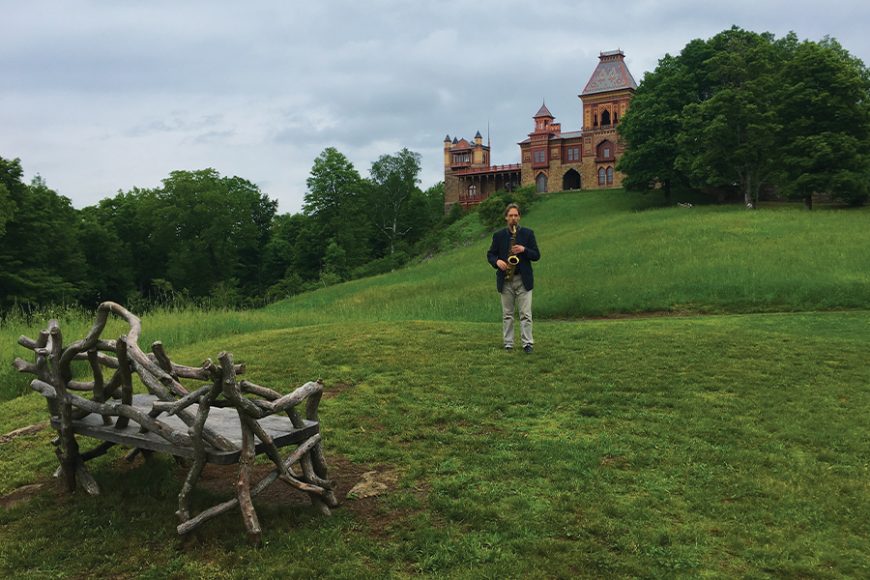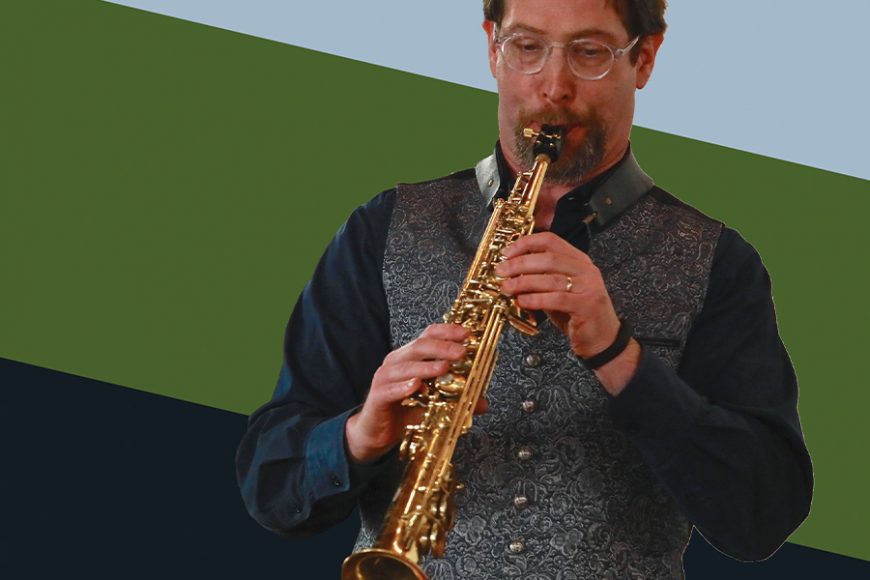Imagine the scene – a room filled with people who have listened to lecture after lecture at the fourth annual “Mansions of the Gilded Age” Symposium.
It was nearing the end of an informative — if quite long — Sunday at Lyndhurst in Tarrytown this past April.
With thoughts already turning to the drive home and the week ahead, there might have been, shall we say, the temptation to skip the last offering, “Music of the Gilded Age.”
That would have been a mistake.
For Christopher Brellochs, a Hudson Valley musician and academic, would take that final time slot and cap the seminar in style by sharing the adventures of his sabbatical exploring “Music of the Gilded Age in the Hudson Valley.”
As Brellochs told us, he had moved to the region some 12 years ago to join the staff of SUNY Dutchess Community College in Poughkeepsie, where he is an associate professor and the Academy of Music chair. He began exploring the historic homes and sites of his new region.
“I fell in love with the beauty of these houses and the beauty of these landscapes,” he said.
But, he would tour countless parlors and music rooms without a sound to be heard, making it “very easy for it to slip into ‘sterile museum’” mode.
This classical and jazz saxophonist wanted to know what would have filled the air back in the day, what music would have been played for guests after dinner or to fill a leisurely afternoon.
That intense curiosity sparked a sabbatical for the 2018-19 academic year that was keeping Brellochs not only delving into the rare-book collections at Princeton University and the New York Public Library but also boxes and folders of original handwritten music and letters sourced throughout the region to learn the history of the time and the people of the Gilded Age — and then taking the compositions he uncovered and creating programs to perform the music within these historic properties.
His fervor was palpable — “I’m calling myself ‘the Indiana Jones of musical research,’” he said, to resounding laughter — and his enthusiasm contagious.
Brellochs emphasized that while people can certainly hear period music in a concert hall, “It’s a very different experience to hear it in these historic houses … I’m here to rectify this.”
And that he did, joined by pianist Cynthia Peterson, in musical interludes that brought his points to life — and provided a most memorable finale to the symposium held within the Lyndhurst Carriage House.
A TIME TO REFLECT
Fast forward a few months, when WAG is catching up with Brellochs in his DCC office on a late afternoon early in the new school year.
As he shares with a laugh, “My sabbatical is officially over — but they can’t stop me.”
With piano notes giving way to emotive singing in the background — his office is, of course, within the Academy of Music — Brellochs reflects on the year he spent, what he discovered and why it’s a project he’s not about to abandon.
At the start, the task seemed overwhelming, if exciting.
That period in history, he says, is rich in music with both late-19th century European and American composers.
“What’s not so popular is the research into this time period,” he adds. “You don’t have a lot of scholarly research on the Gilded Age, 1860 to 1910, American music.”
He says there is often a focus on the downside of the Gilded Age, the “income inequality, robber barons, labor practices.”
His work, he says, helps put the focus on the contributions of the Gilded Age, a time of possibility.
“I think we can separate. We can get rid of the guilt. We as a culture are looking for that hope.”
To tackle such a broad subject, Brellochs made a plan.
“I did set out parameters … in order not to be overwhelmed,” he says. These included identifying a location or family to study “and any composers I found with any connection with that family.”
But it went beyond that.
“For a musician, you spend a lot of time figuring out what pieces you want to put on a program,” Brellochs says. Then, he says there is the gathering of fellow musicians, rehearsals and more. “After you’ve done all that work, you want to take that program to as many places as you can. I didn’t do that … I made my job one step harder.”
He would tailor performances to each site, sharing the results of his findings.
Three composers who particularly captivated Brellochs with their music are British-born New Yorker Caryl Florio (1843-1920) and Ulysses J. Alsdorf (1872-1952) and William Fullerton Jr. (1854-1888), both of whom had ties to Newburgh in Orange County.
Throughout the project, the Gilded Age music he discovered — which he describes as one that “embraced composers from Europe, was influenced by American styles like marches and later on ragtime and preceded the birth of jazz” — kept Brellochs going.
“I’d like to get that stuff published,” he says. “I’d like to bring it back.”
Not all of it, though.
He says part of his job is to “use my experience in music and education” and “look at these pieces and say ‘This one really stood the test of time.’”
EARLY DAYS
Brellochs, who did his undergraduate work at Ithaca College and earned a doctorate at Rutgers University, was a full-time performer in New York City, playing in jazz clubs such as Birdland and at Carnegie Hall.
He says he was making enough for “food and rent” but not health insurance, so when a back injury hit, he began to consider other options
“Teaching just fell in my lap,” he says of a move that would find him teaching in the public schools in suburban New Jersey. “I ended up really enjoying teaching.”
It was the start of a new path. He would continue to perform, locally and internationally, but devoted his full-time attention to academics, which brought him to the Hudson Valley.
“It absolutely keeps me on my toes to be in the classroom,” says Brellochs, no doubt a popular figure who has been known to reference Dvorak or Tchaikovsky one moment, Beyoncé at another.
THE EFFECT
Brellochs has presented work, performances and lectures at historic destinations throughout the region, including The Crawford House in Newburgh, Boscobel House and Gardens in Garrison, Montgomery Place in Red Hook and Olana State Historic Site in Hudson, where he interspersed a landscape walking tour with music. Many of his performances — plus site tours and interviews — have been documented in a video series that he is developing with a filmmaker in hopes of reaching an even-wider audience.
“The goal is to take it to the local PBS (stations),” for consideration, he says. “That’s my dream. That would be fantastic.”
And he continues to explore another dream — becoming somehow involved with Julian Fellowes’ “The Gilded Age,” the anticipated next step from the writer behind “Downton Abbey.”
All is tied to Brellochs’ evocative way of bringing something “more” to historic surroundings.
Howard Zar, the executive director of Lyndhurst, a National Trust for Historic Preservation site, says he was captivated by Brelloch’s idea to “reintroduce the lost parlor music of the Gilded Age to the mansions of the Hudson Valley” and brought him to Lyndhurst to perform during the 2018 holiday season.
“I think it gave our members the true feeling of what it was like to listen to period chamber music in the setting that it was originally intended for. It’s a very unique experience to be able to be close to a performer and hear their music in the perfect acoustics of a parlor rather than a concert hall. Even for those who aren’t music lovers, per se, this was a unique experience.”
It’s one Brellochs is committed to continuing, noting he’s in talks to work with a few local sites and has an ever-growing wish list that includes Kykuit in Pocantico Hills and Glenview Mansion at the Hudson River Museum in Yonkers. Beyond, he’d love to explore the musical history of the Gilded Age in New York City, Long Island’s Gold Coast and Newport, Rhode Island.
“I think the time is right for a renewed interest in the Gilded Age,” he says. “There are lessons that can be learned.”
Brellochs seems to have found a singular way to connect the Gilded Age to today.
“Music is unique in the art forms,” he says. “It reaches right into your soul and can make you feel something.”
Now fully immersed in the school year, Brellochs admits he has less time to focus on the ongoing Gilded Age project — but is far from discouraged.
“You get a sabbatical every seven years — and I’ve already marked it on my calendar.”
For more, visit christopherbrellochs.com.






